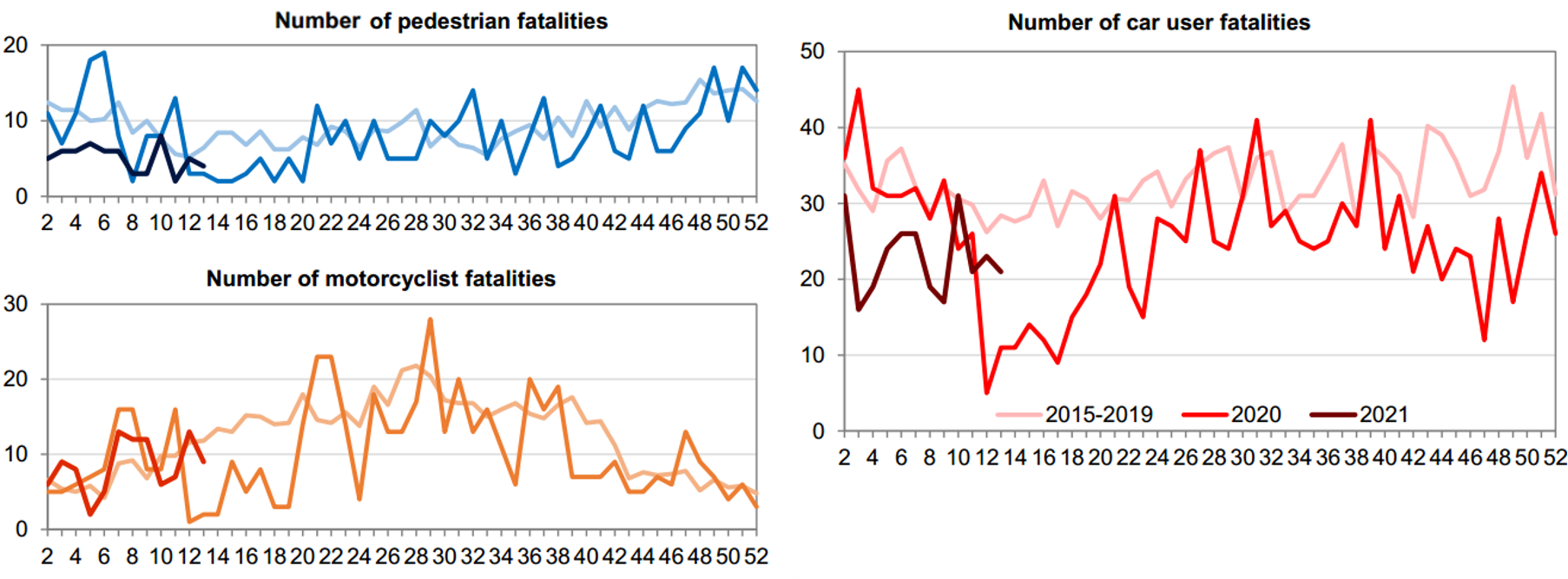The travel restrictions linked to the curfew in particular have reduced road accidents. Unlike the first lockdown in 2020, the number of fatalities has fallen more than the number of injuries.
As part of the Covid 19 crisis management, a 6pm to 6am curfew was introduced in mainland France for most of the first quarter of 2021. Teleworking was still heavily used to reduce travel, restaurants, bars and nightclubs were closed for the whole period, and many shops were closed for part of the period. These measures had repercussions on economic activity, on the movement of the population, and above all on social outings at night. Road accidents were greatly reduced during curfew hours.
The analysis of the first quarter of 2021 is presented in the ONISR's quarterly barometer
Since the beginning of 2021, accident rates remain below the January 2020 level, while traffic returns to the January 2020 level in the second half of February. Since the travel restrictions in March 2021, traffic has fallen again, but the number of speeding tickets does not follow the traffic trend and remains stable, suggesting more frequent speeding.
The study of accidents and fatalities for the first quarter of 2021 shows a reduction in accidents compared with the average for the first quarters of the five years prior to the health crisis (2015-2019), with a greater reduction in the number of fatalities than in the number of injuries.
Mortality by mode of travel, by week, illustrates the effect of the curfew on pedestrian mortality, traditionally high in winter due to the commuting after dark. This year the curfew means that people have to go home while it is still light. Motorist deaths have fallen significantly, particularly because night-time outings are no longer authorised, but also because teleworking is still strongly promoted to reduce the spread of COVID, as shown by the Cerema traffic index. On the other hand, motorcyclist mortality is relatively equivalent to the average of previous years, excluding the health crisis.

What is the accident pattern in the first quarter of 2021?
With teleworking, the number of accidents decreases during the day. The curfew brings forward the evening peak.
Analysis of the reduction in fatalities by time of day indicates a greater reduction in fatalities during curfew hours than during the day, which explains the greater reduction in fatalities than in injuries.
Overall fatalities decreased by -29% in the period January to March 2021 compared to the average of the last 5 years before the health crisis. Motorist and pedestrian fatalities contribute most to the decrease (1/3 and 2/3 respectively). Motorcyclist deaths are stable (-4%). Cyclist deaths are increasing (+30%).
The decreases in fatalities for the over 75s (-37%), 45-64s (-35%) and 25-44s (-33%) are greater than the overall decrease, contributing respectively to 1/5, 1/4 and 1/3 of the fewer deaths. Women's mortality, which is much lower than that of men, fell even more (-40%) than that of men (-31%). This decrease represents more than 1/4 of the overall decrease.
Cycling deaths on roads outside built-up areas are increasing
34 cyclists were killed in the first quarter of 2021 (11 in built-up areas and 23 outside built-up areas) compared with an average of 26 killed over the first quarters of 2015-2019 (12 in built-up areas and 14 outside built-up areas). 80% of cyclists killed are aged 55 or over.
Cyclist deaths outside built-up areas increased by 64% in the first quarter of 2021 compared to the average for 2015-2019, whereas they were stable in built-up areas. 68% of cyclists killed this quarter were killed outside built-up areas, while 16% of cyclists injured were recorded by the police.
Data source : ONISR - Data on accidents involving injuries recorded by police forces - Geographical area : France mainland
Labelled series (definitive until 2019, quasi-definitive2020), 2021 estimate based on data as of 08/04/2021

